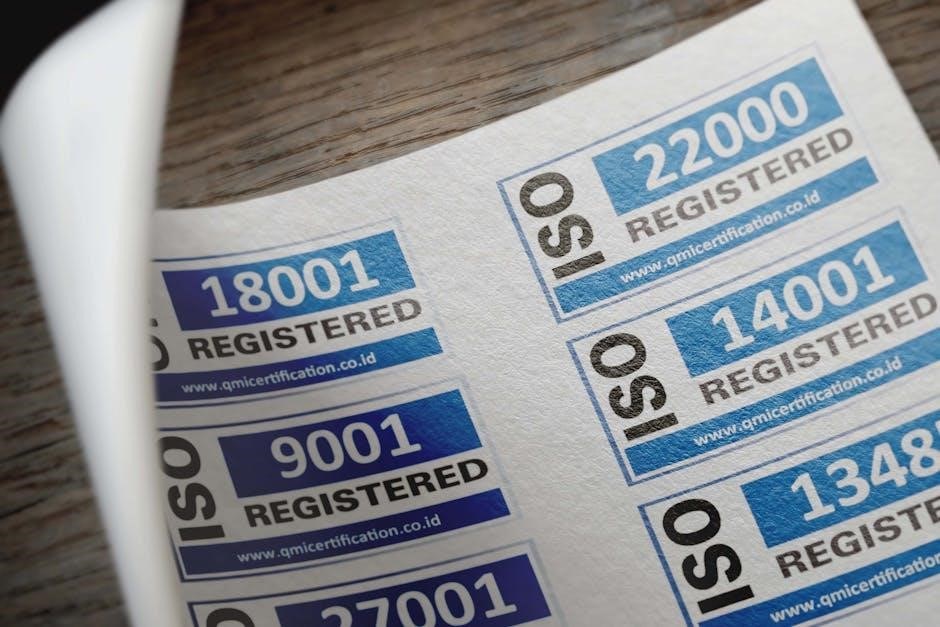ISO 27001 is the global standard for Information Security Management Systems (ISMS)‚ published in 2005. It provides a framework to manage information security risks effectively.
1.1. What is ISO 27001?
ISO 27001 is an internationally recognized standard for Information Security Management Systems (ISMS)‚ published in 2005. It provides a framework for organizations to manage and protect information assets systematically. The standard emphasizes risk management‚ security controls‚ and continuous improvement‚ helping entities of all sizes and industries ensure data integrity and confidentiality. Widely adopted globally‚ ISO 27001 certification demonstrates an organization’s commitment to robust information security practices‚ enhancing trust and credibility in the market.
1.2. History and Evolution of ISO 27001
ISO 27001 was first published in 2005‚ replacing the British Standard BS 7799-2. It evolved from earlier frameworks focused on information security‚ reflecting global demand for standardized practices. The 2013 revision aligned with ISO’s Annex SL structure‚ enhancing compatibility with other management systems. The 2022 update incorporated feedback from global industries‚ refining control sets and emphasizing adaptability to emerging threats and technologies‚ ensuring the standard remains relevant and effective in safeguarding information assets.
1.3. Importance of ISO 27001 in Information Security
ISO 27001 plays a pivotal role in information security by providing a globally recognized framework for managing risks. It ensures the confidentiality‚ integrity‚ and availability of data‚ which is crucial for building trust with clients and stakeholders. Compliance with ISO 27001 demonstrates an organization’s commitment to robust security practices‚ reducing vulnerabilities and safeguarding sensitive information against evolving cyber threats. This standard is essential for organizations aiming to maintain a secure and resilient information infrastructure.

Benefits of Implementing ISO 27001
Implementing ISO 27001 enhances trust‚ streamlines processes‚ and ensures compliance with international standards‚ providing a competitive edge‚ building customer confidence‚ and safeguarding sensitive data effectively.
2.1. Enhanced Trust and Credibility
ISO 27001 certification significantly enhances an organization’s trust and credibility. It demonstrates a commitment to protecting sensitive information‚ ensuring compliance with global standards. This fosters confidence among clients‚ stakeholders‚ and partners‚ highlighting the organization’s dedication to security best practices. Achieving ISO 27001 certification acts as a powerful differentiator‚ reinforcing the organization’s reputation as a secure and reliable entity in the market.
2.2. Improved Information Security Posture
Implementing ISO 27001 significantly strengthens an organization’s information security posture by establishing a robust ISMS. It ensures the identification and mitigation of risks‚ safeguarding sensitive data from threats. The standard’s framework provides clear guidelines for security controls‚ improving overall resilience. This structured approach helps organizations maintain high levels of security‚ ensuring business continuity and protecting assets from evolving cyber threats effectively.
2.3. Compliance with International Standards
Adhering to ISO 27001 ensures compliance with globally recognized information security standards. This alignment simplifies meeting regulatory requirements and industry best practices‚ enhancing organizational credibility. By following the standard’s guidelines‚ businesses demonstrate their commitment to security‚ making it easier to operate across borders and industries. Compliance also facilitates audits and certifications‚ streamlining processes for maintaining international standards and fostering trust among clients and stakeholders worldwide.
2.4. Competitive Advantage in the Market
ISO 27001 certification offers a significant competitive edge by showcasing an organization’s commitment to robust information security. This differentiation attracts clients and partners who prioritize data protection‚ enhancing business opportunities. Certified companies are often favored in tender processes and partnerships‚ as the standard demonstrates reliability and trustworthiness. In a crowded market‚ ISO 27001 acts as a powerful differentiator‚ reinforcing an organization’s reputation and positioning it as a leader in information security and governance.

Key Components of ISO 27001 Standard
ISO 27001 comprises core elements like ISMS‚ risk management framework‚ documented policies‚ and control objectives. These components ensure a robust approach to information security governance and compliance.
3.1. Information Security Management System (ISMS)
An ISMS is a systematic approach to managing sensitive information. It encompasses policies‚ processes‚ and technologies to protect data. The ISO 27001 standard provides a framework for implementing an ISMS‚ ensuring confidentiality‚ integrity‚ and availability of information. By defining roles‚ responsibilities‚ and risk management strategies‚ an ISMS helps organizations align their security practices with business objectives and comply with legal requirements.
3.2. Risk Management Framework
The ISO 27001 Risk Management Framework is a structured approach to identify‚ assess‚ and treat information security risks. It ensures that organizations can systematically evaluate threats and vulnerabilities‚ aligning with their risk appetite. By implementing this framework‚ businesses can prioritize controls‚ optimize resources‚ and maintain compliance‚ ultimately safeguarding their assets and ensuring the effectiveness of their information security management system. This framework is crucial for adapting to evolving security challenges.

3.3. Documented Policies and Procedures
Documented policies and procedures are essential for ISO 27001 compliance‚ providing clear guidelines for information security practices. These documents outline roles‚ responsibilities‚ and processes‚ ensuring consistency and accountability. Policies address information security objectives‚ risk management‚ and compliance‚ while procedures detail implementation steps. Proper documentation helps organizations demonstrate adherence to the standard during audits and certifications‚ ensuring a robust and maintainable Information Security Management System (ISMS).
3.4. Control Objectives and Requirements
ISO 27001 defines control objectives and requirements to ensure effective information security management. These objectives align with organizational goals‚ addressing risks and safeguarding assets. Requirements specify mandatory actions‚ such as access controls and incident management. Annex A provides a detailed list of controls‚ enabling organizations to select and implement measures suited to their needs. Adhering to these requirements ensures compliance‚ robust security‚ and successful certification‚ demonstrating a commitment to protecting sensitive information.

Steps to Implement ISO 27001
Implementing ISO 27001 involves understanding requirements‚ conducting a gap analysis‚ developing a project plan‚ implementing controls‚ and undergoing internal audits and certification to ensure compliance and effectiveness.
4.1. Understanding the Standard and Its Requirements
Understanding ISO 27001 involves grasping its framework for managing information security risks. The standard outlines requirements for establishing‚ implementing‚ and maintaining an ISMS. It provides a structured approach to identifying and mitigating risks‚ ensuring confidentiality‚ integrity‚ and availability of information assets. Organizations must familiarize themselves with its clauses‚ control objectives‚ and documentation requirements to align their security practices with global best practices‚ ensuring compliance and effective implementation.
4.2. Conducting a Gap Analysis
Conducting a gap analysis is a critical step in ISO 27001 implementation. It involves assessing an organization’s current information security practices against the standard’s requirements. This process identifies gaps‚ such as inadequate policies‚ insufficient controls‚ or missing documentation. By evaluating existing security measures‚ organizations can pinpoint deficiencies and develop a roadmap to address them. A thorough gap analysis ensures alignment with ISO 27001‚ facilitating a structured approach to achieving compliance and improving the overall information security posture.
4.3. Developing a Project Plan
Developing a project plan is essential for ISO 27001 implementation. It outlines timelines‚ milestones‚ and responsibilities‚ ensuring alignment with organizational goals. The plan should include resource allocation‚ budget details‚ and task assignments. Regular monitoring and adjustments are crucial to stay on track. A well-structured project plan helps organizations manage complexities and achieve certification efficiently‚ ensuring all requirements are met systematically.
4.4. Implementing Controls and Policies
Implementing controls and policies is a critical step in achieving ISO 27001 certification. It involves defining and executing security measures aligned with organizational objectives. The standard provides a framework for establishing documented policies and procedures‚ ensuring compliance with its requirements. By integrating these controls into daily operations‚ organizations can effectively manage risks and maintain a robust information security management system. This step ensures that all security practices are aligned with the standard’s guidelines‚ fostering a secure and compliant environment.
4.5. Internal Audits and Certification
Internal audits are essential to ensure compliance with ISO 27001 requirements and prepare for certification. These audits verify the effectiveness of implemented controls and policies‚ identifying gaps and areas for improvement. Successful completion of internal audits demonstrates readiness for formal certification by an accredited body. Certification confirms an organization’s commitment to information security and enhances credibility. Regular audits also ensure continuous compliance and improvement‚ maintaining a robust information security management system over time.

How to Download ISO 27001 Standard PDF for Free
Access the ISO 27001 standard PDF through official sources like ISO.org or authorized distributors. Be cautious of unauthorized sites offering free downloads‚ ensuring compliance with copyright laws.
5.1. Official Sources for ISO 27001 PDF
The ISO 27001 standard PDF can be obtained from official sources like ISO.org‚ the British Standards Institution (BSI)‚ or the American National Standards Institute (ANSI). These platforms provide authentic and up-to-date versions of the standard. Purchasing directly ensures compliance with copyright laws and guarantees access to the full‚ unaltered document. Avoid unauthorized websites offering free downloads‚ as they may violate intellectual property rights or provide incomplete versions.
5.2. Reliable Websites for Free Download
While the full ISO 27001 standard is not freely available‚ some websites offer preview versions or summaries. Platforms like Tech-ARQ or Standards Direct provide limited free access. Additionally‚ SAI Global offers free trials for ISO standards; Always verify the authenticity and authority of these sources to ensure compliance and avoid unauthorized versions; Free downloads are typically restricted to partial content‚ requiring purchase for the full document.
5.3. Avoiding Unauthorized or Illegal Downloads
Downloading ISO 27001 standards from unauthorized sources is illegal and violates copyright laws. Such downloads may contain inaccurate or altered content‚ posing risks to compliance efforts. Unauthorized versions often lack official validation‚ leading to potential legal penalties for organizations using them. Always obtain ISO 27001 documents from official sources or authorized resellers to ensure authenticity and compliance with copyright regulations. This supports the integrity of your information security initiatives.

Understanding the Structure of ISO 27001 PDF
The ISO 27001 PDF structure includes main clauses detailing requirements‚ annexes listing controls‚ and guidance for effective ISMS implementation and compliance.
6.1. Clauses and Control Requirements
The ISO 27001 PDF outlines specific clauses that define the requirements for an Information Security Management System (ISMS). These clauses are organized into key areas such as organizational context‚ leadership‚ planning‚ support‚ operation‚ performance evaluation‚ and improvement. The standard also includes control requirements‚ with Annex A providing a detailed list of security controls. These controls are categorized into different sections‚ ensuring comprehensive coverage of information security risks. The PDF structure ensures clarity and ease of reference for organizations aiming to implement the standard effectively.
6.2. Annexes and Appendices
The ISO 27001 PDF includes annexes and appendices that provide additional guidance and support for implementing the standard. Annex A lists 114 security controls‚ categorized into 14 clauses‚ offering detailed measures to mitigate risks. Other annexes include examples‚ templates‚ and interpretations to aid organizations in aligning with the standard. These sections are invaluable for understanding and applying the requirements effectively‚ ensuring a robust Information Security Management System (ISMS) implementation.
6.3. Guidance for Implementation
The ISO 27001 PDF offers comprehensive guidance for implementing an Information Security Management System (ISMS). It outlines practical steps‚ such as understanding requirements‚ conducting gap analyses‚ and developing a project plan. The document also provides tips for risk assessments‚ control implementation‚ and internal audits. This section ensures organizations can align their processes with the standard‚ facilitating a smooth and effective certification journey. The guidance is tailored for organizations of all sizes and industries‚ promoting adaptability and compliance.

Common FAQs About ISO 27001 Standard
ISO 27001 is an international standard for Information Security Management Systems (ISMS)‚ published in 2005. It helps organizations manage information security risks effectively and ensures compliance.
7.1. Is ISO 27001 Free to Download?
No‚ ISO 27001 is not free to download. The standard must be purchased through official ISO or authorized distributors. Free downloads are typically unauthorized and illegal.
7.2. What Is the Difference Between ISO 27001:2013 and ISO 27001:2022?
ISO 27001:2022 introduces updated control sets and focuses on modern risks like cyber threats. It replaces the 2013 version with revised Annex A controls and improved frameworks.
7.3. Can Small Businesses Benefit from ISO 27001?
Yes‚ small businesses can greatly benefit from ISO 27001. It helps manage information security risks‚ protect sensitive data‚ and enhance customer trust. The standard provides a scalable framework that suits organizations of all sizes‚ ensuring compliance with international security standards and improving overall cybersecurity posture. This makes it an invaluable tool for small businesses aiming to secure their operations and gain a competitive edge in the market.

Case Studies and Success Stories
Organizations like Inveniam Capital Partners and KuCoin have successfully implemented ISO 27001‚ enhancing their information security and gaining client trust‚ showcasing its effectiveness in real-world scenarios.
8.1. Organizations That Have Successfully Implemented ISO 27001
Leading organizations like Inveniam Capital Partners‚ KuCoin‚ and Altenar have successfully achieved ISO 27001 certification. These companies highlight the standard’s effectiveness in enhancing information security. Inveniam Capital Partners‚ a global data infrastructure leader‚ demonstrated robust security controls‚ while KuCoin‚ a prominent cryptocurrency platform‚ strengthened user trust. Altenar and Olla Systems also showcased improved operational stability and competitive advantage through certification‚ proving ISO 27001’s value across industries and sizes.
8.2. Benefits Reported by Certified Companies
Certified companies report enhanced credibility‚ strengthened client trust‚ and improved operational stability. Many highlight increased efficiency in managing information security risks. Organizations like Inveniam Capital Partners and KuCoin note that ISO 27001 certification has bolstered their market reputation‚ demonstrating commitment to global security standards. Additionally‚ companies emphasize the framework’s role in achieving compliance and gaining a competitive edge‚ fostering customer confidence and long-term business growth through robust security controls and effective risk management practices.
8.3. Lessons Learned from Implementation
Organizations that have implemented ISO 27001 highlight the importance of aligning with global security standards and maintaining robust controls. Companies like Inveniam Capital Partners and KuCoin emphasize the value of thorough documentation and continuous improvement. They also stress the need for a strong commitment to information security and effective risk management. The certification process underscores the importance of ongoing effort to maintain compliance and adapt to evolving security threats‚ ensuring long-term protection of sensitive data and systems.
ISO 27001 is a pivotal standard for safeguarding data‚ offering a robust framework for modern businesses to ensure security‚ trust‚ and compliance while driving continuous improvement.
9.1. Final Thoughts on ISO 27001 Standard
ISO 27001 stands as a cornerstone for information security‚ offering organizations a comprehensive framework to protect sensitive data. Its structured approach ensures compliance‚ enhances credibility‚ and fosters trust among stakeholders. By implementing ISO 27001‚ businesses demonstrate a commitment to safeguarding assets and adapting to evolving security threats in an increasingly digital world.
9.2. Encouragement to Adopt the Standard
Adopting ISO 27001 is a strategic move to enhance your organization’s information security posture. It offers a structured framework to protect sensitive data‚ ensuring compliance with global standards. By implementing ISO 27001‚ businesses can build trust with stakeholders‚ mitigate risks‚ and gain a competitive edge. The standard’s flexibility makes it suitable for organizations of all sizes and industries‚ providing a clear path to achieving robust information security management.

Additional Resources
Explore official ISO websites‚ training courses‚ and books for deeper insights. Utilize online platforms like LinkedIn Learning and Coursera for ISO 27001-specific tutorials and guidance.
10.1. Recommended Reading and References
For in-depth understanding‚ refer to official ISO publications and certified guides. ISO 27001:2022 for Small Businesses by Alan Calder is a highly recommended resource. Additionally‚ explore ISO/IEC 27001:2022 – The Standard for detailed control objectives. Online training courses on platforms like Coursera and LinkedIn Learning offer practical insights. Visit the official ISO website for authentic materials and updates on the standard.
10.2. Training Courses and Tutorials
Enroll in certified ISO 27001 training courses offered by platforms like Coursera‚ LinkedIn Learning‚ and Udemy. These courses cover ISMS implementation‚ risk assessment‚ and compliance. The official ISO website provides tutorials and webinars for deeper understanding. Additionally‚ organizations like BSI and PECB offer specialized training programs. These resources are ideal for professionals aiming to master ISO 27001 and prepare for certification‚ ensuring practical application of the standard in real-world scenarios.